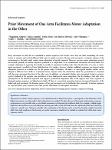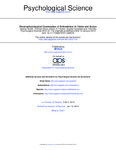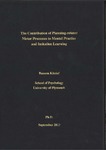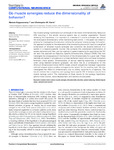Prior Movement of One Arm Facilitates Motor Adaptation in the Other
| dc.contributor.author | Gippert, M | |
| dc.contributor.author | Leupold, S | |
| dc.contributor.author | Heed, T | |
| dc.contributor.author | Howard, IS | |
| dc.contributor.author | Villringer, A | |
| dc.contributor.author | Nikulin, VV | |
| dc.contributor.author | Sehm, B | |
| dc.date.accessioned | 2023-08-01T20:31:44Z | |
| dc.date.available | 2023-08-01T20:31:44Z | |
| dc.date.issued | 2023-06-07 | |
| dc.identifier.issn | 0270-6474 | |
| dc.identifier.issn | 1529-2401 | |
| dc.identifier.uri | https://pearl.plymouth.ac.uk/handle/10026.1/21127 | |
| dc.description.abstract |
Many movements in daily life are embedded in motion sequences that involve more than one limb, demanding the motor system to monitor and control different body parts in quick succession. During such movements, systematic changes in the environment or the body might require motor adaptation of specific segments. However, previous motor adaptation research has focused primarily on motion sequences produced by a single limb, or on simultaneous movements of several limbs. For example, adaptation to opposing force fields is possible in unimanual reaching tasks when the direction of a prior or subsequent movement is predictive of force field direction. It is unclear, however, whether multilimb sequences can support motor adaptation processes in a similar way. In the present study (38 females, 38 males), we investigated whether reaches can be adapted to different force fields in a bimanual motor sequence when the information about the perturbation is associated with the prior movement direction of the other arm. In addition, we examined whether prior perceptual (visual or proprioceptive) feedback of the opposite arm contributes to force field-specific motor adaptation. Our key finding is that only active participation in the bimanual sequential task supports pronounced adaptation. This result suggests that active segments in bimanual motion sequences are linked across limbs. If there is a consistent association between movement kinematics of the linked and goal movement, the learning process of the goal movement can be facilitated. More generally, if motion sequences are repeated often, prior segments can evoke specific adjustments of subsequent movements.</jats:p><jats:p><jats:bold>SIGNIFICANCE STATEMENT</jats:bold>Movements in a limb's motion sequence can be adjusted based on linked movements. A prerequisite is that kinematics of the linked movements correctly predict which adjustments are needed. We show that use of kinematic information to improve performance is even possible when a prior linked movement is performed with a different limb. For example, a skilled juggler might have learned how to correctly adjust his catching movement of the left hand when the right hand performed a throwing action in a specific way. Linkage is possibly a key mechanism of the human motor system for learning complex bimanual skills. Our study emphasizes that learning of specific movements should not be studied in isolation but within their motor sequence context. | |
| dc.format.extent | 4341-4351 | |
| dc.format.medium | Print-Electronic | |
| dc.language | en | |
| dc.publisher | Society for Neuroscience | |
| dc.subject | bimanual | |
| dc.subject | motor adaptation | |
| dc.subject | motor control | |
| dc.subject | motor learning | |
| dc.subject | motor sequence | |
| dc.subject | sequence learning | |
| dc.title | Prior Movement of One Arm Facilitates Motor Adaptation in the Other | |
| dc.type | journal-article | |
| dc.type | Article | |
| plymouth.author-url | https://www.ncbi.nlm.nih.gov/pubmed/37160362 | |
| plymouth.issue | 23 | |
| plymouth.volume | 43 | |
| plymouth.publication-status | Published | |
| plymouth.journal | The Journal of Neuroscience | |
| dc.identifier.doi | 10.1523/jneurosci.2166-22.2023 | |
| plymouth.organisational-group | |Plymouth | |
| plymouth.organisational-group | |Plymouth|Faculty of Science and Engineering | |
| plymouth.organisational-group | |Plymouth|Faculty of Science and Engineering|School of Engineering, Computing and Mathematics | |
| plymouth.organisational-group | |Plymouth|REF 2021 Researchers by UoA | |
| plymouth.organisational-group | |Plymouth|Users by role | |
| plymouth.organisational-group | |Plymouth|Users by role|Academics | |
| plymouth.organisational-group | |Plymouth|REF 2021 Researchers by UoA|UoA11 Computer Science and Informatics | |
| dc.publisher.place | United States | |
| dcterms.dateAccepted | 2023-04-18 | |
| dc.date.updated | 2023-08-01T20:31:38Z | |
| dc.rights.embargodate | 2023-11-9 | |
| dc.identifier.eissn | 1529-2401 | |
| dc.rights.embargoperiod | forever | |
| rioxxterms.versionofrecord | 10.1523/jneurosci.2166-22.2023 |





